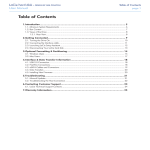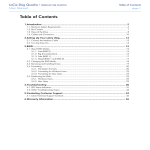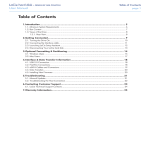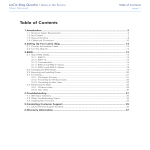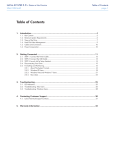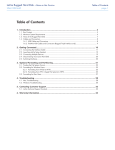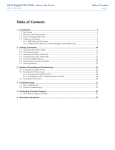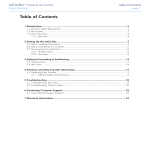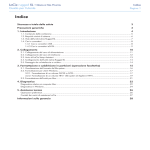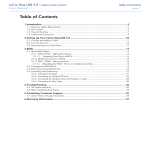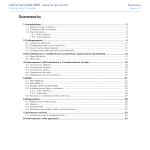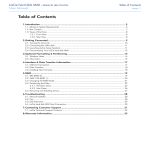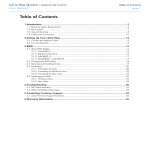Download LaCie DUAL DRIVE
Transcript
LaCie hard disk MAX • DESIGN BY NEIL POULTON User Manual Table of Contents page 1 Table of Contents 1.Introduction............................................................................................................... 5 1.1.Minimum System Requirements...................................................................................................... 6 1.2.Box Content................................................................................................................................. 7 1.3.Views of the Drive......................................................................................................................... 8 1.3.1. Front View.......................................................................................................................... 8 1.3.2. Rear View........................................................................................................................... 8 2.Getting Connected..................................................................................................... 9 2.1.Turning the Drive On.................................................................................................................. 10 2.2.Connecting the Interface cable..................................................................................................... 11 2.3.Launching LaCie Setup Assistant................................................................................................... 12 2.4.Disconnecting Your LaCie hard disk MAX...................................................................................... 13 3.Optional Formatting & Partitioning.......................................................................... 14 3.1.Windows Users........................................................................................................................... 15 3.2.Mac Users.................................................................................................................................. 17 4.Interface & Data Transfer Information..................................................................... 18 4.1.USB 2.0 Connection................................................................................................................... 18 4.2.FireWire Connections.................................................................................................................. 18 4.3.eSATA Cables and Connectors..................................................................................................... 19 4.4.Data Transfers............................................................................................................................ 20 4.5.Installing New Firmware.............................................................................................................. 20 5.RAID........................................................................................................................ 21 5.1.FAST (RAID 0)............................................................................................................................. 21 5.2.SAFE (RAID 1)............................................................................................................................. 22 5.3.Changing the RAID Mode............................................................................................................ 23 5.4.Partitioning the Disks................................................................................................................... 24 5.4.1. Windows Users................................................................................................................. 24 5.4.2. Mac Users....................................................................................................................... 28 5.5.Removing and Installing Drives..................................................................................................... 29 6.Troubleshooting...................................................................................................... 30 6.1.Manual Updates......................................................................................................................... 30 6.2.Fan............................................................................................................................................ 30 6.3.LED Indicators............................................................................................................................ 31 6.4.Troubleshooting the Host Connection........................................................................................... 32 7.Contacting Customer Support.................................................................................. 33 7.1.LaCie Technical Support Contacts................................................................................................ 34 8.Warranty Information.............................................................................................. 35 LaCie hard disk MAX • DESIGN BY NEIL POULTON User Manual Copyrights Copyright © 2010 LaCie. All rights reserved. No part of this publication may be reproduced, stored in a retrieval system, or transmitted in any form or by any means, electronic, mechanical, photocopying, recording or otherwise, without the prior written consent of LaCie. Trademarks Apple, Mac, and Macintosh are registered trademarks of Apple Computer, Inc. Microsoft, Windows 7, Windows XP and Windows Vista are registered trademarks of Microsoft Corporation. Other trademarks mentioned in this manual are the property of their respective owners. Changes The material in this document is for information only and subject to change without notice. While reasonable efforts have been made in the preparation of this document to assure its accuracy, LaCie assumes no liability resulting from errors or omissions in this document, or from the use of the information contained herein. LaCie reserves the right to make changes or revisions in the product design or the product manual without reservation and without obligation to notify any person of such revisions and changes. Canada Compliance Statement This Class A digital apparatus meets all requirements of the Canadian Interference-Causing Equipment Regulations. 100405 v2.1 Foreword page 2 FCC Statement ✦✦ Reorient or relocate the receiving antenna. LaCie hard disk MAX Tested to comply with FCC standards for home or office use This device complies with Part 15 of the FCC Rules. Operation is subject to the following conditions: ✦✦ The devices may not cause harmful interference ✦✦ The devices must accept any interference received, including interference that may cause undesired operation. NOTE: This equipment has been tested and found to comply with the limits for a Class B digital device, pursuant to Part 15 of the FCC Rules. These limits are designed to provide reasonable protection against harmful interference in a residential installation. This equipment generates, uses and can radiate radio frequency energy and, if not installed and used in accordance with the instructions, may cause harmful interference to radio communications. However, there is no guarantee that interference will not occur in a particular installation. If this equipment does cause harmful interference to radio or television reception, which can be determined by turning the equipment off and on, the user is encouraged to try and correct the interference by one or more of the following measures: ✦✦ Increase the separation between the equipment and receiver. ✦✦ Connect the equipment into an outlet on a circuit different from that to which the receiver is connected. ✦✦ Consult the dealer or an experienced radio/TV technician for help. Modifications to this product not authorized by LaCie could void the FCC & Industry Canada regulations and negate your authority to operate the product. CAUTION: Modifications not authorized by the manufacturer may void the user’s authority to operate this device. Manufacturer’s Declaration for CE Certification We, LaCie, solemnly declare that this product conforms to the following European standards: Class B EN60950, EN55022, EN55024 With reference to the following conditions: 73/23/EEC Low Voltage Directive; 89/336/EEC EMC Directive LaCie hard disk MAX • DESIGN BY NEIL POULTON User Manual This symbol on the product or on its packaging indicates that this product must not be disposed of with your other household waste. Instead, it is your responsibility to dispose of your waste equipment by handing it over to a designed collection point for the recycling of waste electrical and electronic equipment. The separate collection and recycling of your waste equipment at the time of disposal will help to conserve natural resources and ensure that it is recycled in a manner that protects human health and the environment. For more information about where you can drop off your waste equipment for recycling, please contact your local city office, your household waste disposal service, or the shop where you purchased the product. Health & Safety Requirements ✦✦ Only qualified persons are authorized to carry out maintenance on this device. ✦✦ Read this user manual carefully and follow the correct procedure when setting up the device. ✦✦ Do not open your LaCie hard disk MAX or attempt to disassemble or modify it. Never insert any metallic object into the drive to avoid any risk of electrical shock, fire, shortcircuiting or dangerous emissions. Your LaCie hard disk MAX contains no user-serviceable parts. If it appears to be malfunctioning, have it inspected by a qualified LaCie Technical Support representative. ✦✦ Never expose your device to rain, or use it near water, or in damp or wet conditions. Never place objects containing liquids on the LaCie hard disk MAX, as they may spill into its openings. Doing so increases the risk of electrical shock, shortcircuiting, fire or personal injury. General use Precautions ✦✦ Do not expose the LaCie hard disk MAX to temperatures outside the range of 5° C to 35° C (41° F to 95° F); or to operational humidity beyond 5-80%, non-condensing, or non-operating humidity beyond 1090%, non-condensing. Doing so may damage the LaCie hard disk MAX or disfigure its casing. Avoid placing your LaCie hard disk MAX near a source of heat or exposing it to sunlight (even through a window). Inversely, placing your LaCie hard disk MAX in an environment that is too cold or humid may damage the unit. Because of heat issues, LaCie recommends that users do not stack drives. ✦✦ Always unplug the LaCie hard disk MAX from the electrical outlet if there is a risk of lightning or if it will be unused for an extended period of time. Otherwise, there is an increased risk of electrical shock, short-circuiting or fire. ✦✦ Use only the power supply shipped with the device. ✦✦ Do not use the LaCie hard disk MAX near other electrical appliances such as televisions or radios. Doing so may cause interference which will adversely affect the operation of the other products. ✦✦ Do not place the LaCie hard disk MAX near sources of magnetic interference, such as computer displays, televisions or speakers. Magnetic interference can affect the operation and stability of your LaCie hard disk MAX. ✦✦ Do not place heavy objects on top of the LaCie hard disk MAX or use excessive force on it. ✦✦ Never use excessive force on your LaCie hard disk MAX. If you detect a problem, see the Troubleshooting section in this manual. CAUTION: A shielded-type power cord Foreword page 3 is required in order to meet FCC emission limits and also to prevent interference to the nearby radio and television reception. It is essential that only the supplied power cord be used. LaCie hard disk MAX • DESIGN BY NEIL POULTON User Manual Foreword page 4 IMPORTANT INFO: Any loss, corruption or destruction of data while using a LaCie drive is the sole responsibility of the user, and under no circumstances will LaCie be held liable for the recovery or restoration of this data. To help prevent the loss of your data, LaCie highly recommends that you keep TWO copies of your data; one copy on your external hard disk, for instance, and a second copy either on your internal hard disk, another external hard disk or some other form of removable storage media. LaCie offers a complete line of CD and DVD drives. If you would like more information on backup, please refer to our website. IMPORTANT INFO: 1GB = 1,000,000,000 bytes. 1TB = 1,000,000,000,000 bytes. Once formatted, the actual available storage capacity varies depending on operating environment (typically 5-10% less). LaCie hard disk MAX • DESIGN BY NEIL POULTON User Manual Introduction page 5 1.Introduction Building on over a decade of design excellence, LaCie has created a new line of drives that are timeless and crafted to blend functionality with high-technology. These latest drives are performance-based solutions that will power you through your specific applications. Ideal for speed intensive applications, the LaCie hard disk MAX handles the curves of your demanding data needs. Secure and stable, the LaCie hard disk MAX is an ideal way to add space to your computer; you can divide the drive into specific spaces (partitions) for different parts of your data, or leave it alone and simply use it as one big volume. Features ✦✦ ✦✦ ✦✦ ✦✦ Simple and efficient dual-disk hard disk RAID: FAST & SAFE for maximum speed or security USB expansion slot for increased capacity Complete software bundle: easy formatting & backup Quick Links Click a topic: ✦✦ Getting Connected ✦✦ Optional Formatting & Partitioning ✦✦ RAID LaCie hard disk MAX • DESIGN BY NEIL POULTON User Manual 1.1. Minimum System Requirements Your system must meet certain requirements in order for your LaCie product to function properly. For a list of these requirements, please refer to the product packaging or consult the datasheet (from lacie.com/support/). Introduction page 6 LaCie hard disk MAX • DESIGN BY NEIL POULTON User Manual Introduction page 7 1.2. Box Content Your LaCie hard disk MAX package contains the drive itself and an accessories box containing the items listed below. 1. LaCie hard disk MAX, Design by Neil Poulton with two disks for RAID capability 2. External power supply 3. USB 2.0 cable 4. FireWire 800 (9-to-9 pin) cable 5. FireWire 400 to 800 (6-pin to 9-pin) adapter cable 6. eSATA cable 7. Quick Install Guide LaCie Utilities and user manual are located on the drive and will appear once the LaCie Setup Assistance has been installed. For details, refer to section 2.3. Launching LaCie Setup Assistant. IMPORTANT INFO: Please save your packaging. In the event that the drive should need to be repaired or serviced, it must be returned in its original packaging. SATA hard disk MAX D E S I G N BY N E I L P O U LTO N Quick Install Guide Hi-Speed USB 2.0 , FireWire 400, eSATA 3Gbits SATA LaCie hard disk MAX • DESIGN BY NEIL POULTON User Manual Introduction page 8 1.3. Views of the Drive 1.3.1.Front View 1. USB expansion port 2. Blue LED strip indicating drive status (blue = normal, red = disk failure, blinking = disk activity) 1.3.2.Rear View 1. OFF/ON power switch 2. Power supply connection 3. Lower drive status LED 4. Upper drive status LED Fig. 01 5. eSATA port 6. FireWire 800 ports 7. USB 2.0 port 8. RAID selection switch CAUTION: To avoid overheating, the LaCie hard disk MAX should be installed in a well-ventilated area and in such a way as to maintain sufficient airflow across the controller chips. Also ensure that the Ventilation Fan is not obstructed. Please use the included plastic stands and rubber feet which elevate the hard disk Max and allow for better heat dissipation. Environmental Requirements: Temperature: 5 – 35° C (41 – 95° F) Operation Humidity: 5 – 80%, non-condensing STORAGE HUMIDITY: 10 – 90%, non-condensing Fig. 02 LaCie hard disk MAX • DESIGN BY NEIL POULTON User Manual 2.Getting Connected IMPORTANT INFO: Please follow the setup steps in the order they are given to ensure that the LaCie hard disk MAX volume mounts correctly on your computer. Step 1 — 2.1. Turning the Drive On Step 2 — 2.2. Connecting the Interface cable Step 3 — 2.3. Launching LaCie Setup Assistant Getting Connected page 9 LaCie hard disk MAX • DESIGN BY NEIL POULTON User Manual Getting Connected page 10 2.1. Turning the Drive On IMPORTANT INFO: Please connect the power supply before connecting the interface cable to ensure that the volume mounts correctly on your computer. 1. Connect the power supply to a wall outlet and to the hard drive (Fig. 03). 2. Turn on the drive by moving the power switch on the back of the drive to the ON position (Fig. 04). 3. Move on to the next step, section 2.2. Connecting the Interface cable. CAUTION: Only use the AC adapter supplied with your specific LaCie hard disk MAX. Do not use a power supply from another LaCie drive or another manufacturer. Using any other power cable or power supply may cause damage to the device and void your warranty. ALWAYS REMOVE THE AC ADAPTER BEFORE TRANSPORTING YOUR LACIE HARD DISK MAX. FAILURE TO REMOVE THE ADAPTER MAY RESULT IN DAMAGE TO YOUR DRIVE AND WILL VOID YOUR WARRANTY. Fig. 03 TECHNICAL NOTE: You may use your LaCie hard disk MAX when in a foreign country thanks to its 100-240 Volt power supply. To be able to use this feature, you may need to purchase an appropriate adapter or cord. LaCie accepts no responsibility for any damage to the drive resulting from the use of an inappropriate adapter. Using an adapter other than one authorized by LaCie will void your warranty. Fig. 04 LaCie hard disk MAX • DESIGN BY NEIL POULTON User Manual 2.2. Connecting the Interface cable 1. Attach one end of any of the interface cables to an available interface port on your computer (Fig. 05). Getting Connected page 11 TECHNICAL NOTE: If two interfaces are connected at the same time, the first one connected remains active and the second will not work. 2. Connect the other end of the cable to the corresponding interface port on the back of the hard disk MAX. 3. After a few seconds, the hard disk will mount on your computer and appear in My Computer/Computer (Windows users) or on your desktop (Mac users). 4. Proceed to section 2.3. Launching LaCie Setup Assistant. eSATA USB 2.0 FireWire 400 FireWire 800 Fig. 05 LaCie hard disk MAX • DESIGN BY NEIL POULTON User Manual 2.3. Launching LaCie Setup Assistant Before using your drive, LaCie Setup Assistant software must be launched to format your drive. Do not change the RAID mode before running the Setup Assistant. The Setup Assistant should only be run once, and will: ✦✦ Optimize your drive according to your needs ✦✦ Copy the manual and utilities from your drive onto your computer IMPORTANT INFO: LaCie recommends that you copy the user manual and utilities onto your computer’s internal hard drive or other medium when setup is complete. To launch LaCie Setup Assistant: Windows users: double click on the LaCie drive icon in “My Computer” and then double click the LaCie Setup Assistant icon. Mac users: double click on the “LaCie Setup Assistant” icon appear on your desktop and then double click the LaCie Setup Assistant icon. The LaCie Setup Assistant will guide you through the process of optimizing your LaCie hard disk MAX for your needs. IMPORTANT INFO: If you do not launch LaCie Setup Assistant or if you quit LaCie Setup Assistant after formatting has begun, your drive will not be ready to use and will require manual formatting. The user manual and utilities will not be available on your drive and will have to be downloaded from the LaCie website: www.lacie.com. LaCie Setup Assistant should be run just once and is not available for download from the LaCie website. TECHNICAL NOTE: The LaCie Setup Assistant does not prevent you from using your computer’s native disk utility program to format or partition your LaCie drive. Simply follow the Setup Assistant through completion, then use your computer’s native disk utility (Disk Management for Windows or Disk Utility for Mac) to reformat your drive. See section 3. Optional Formatting & Partitioning for more information. Getting Connected page 12 LaCie hard disk MAX • DESIGN BY NEIL POULTON User Manual Getting Connected page 13 2.4. Disconnecting Your LaCie hard disk MAX External USB, FireWire, and eSATA devices feature “plug & play” connectivity, which means that your drive can be connected and disconnected while the computer is running. To prevent failures, however, it is important to follow these steps when disconnecting your LaCie hard drive. Windows Users 1. From the System Tray (located in the lower right-hand side of your screen), click the Eject icon (a small green arrow over a hardware image). 2. A message will appear, listing the devices the Eject icon controls (it should say, “Safely remove...”). Click on the LaCie hard drive in this prompt. 3. This message will appear: “Safe to Remove Hardware” (or similar). It is now safe to disconnect the device. Mac Users 1. Drag the Hard disk MAX drive icon to the trash. (The icon pictured below is a generic USB device icon. Your drive may be represented by an icon that looks like the drive itself.) 2. When the icon disappears from the desktop, the drive can be disconnected. LaCie hard disk MAX • DESIGN BY NEIL POULTON User Manual Formatting & Partitioning page 14 3.Optional Formatting & Partitioning The first time you use your LaCie hard disk MAX, the LaCie Setup Assistant formats your drive according to your needs. If your needs change, you can reformat your LaCie hard disk MAX to optimize it for use with Windows or Mac, or for cross-platform use. For example, if you used LaCie Setup Assistant to format your drive to work with your Mac, but now you want to share your hard disk with Windows users, you can reformat it to FAT 32 (MS-DOS) for this purpose. To reformat your drive, follow the instructions in this section. IMPORTANT INFO: Please copy the User Manual and utilities to your computer before reformatting. Reformatting will erase everything from the hard disk. If you have other data that you want to protect or continue to use, copy this information to your computer before reformatting. What is Formatting? When a disk is formatted, the following things occur: the operating system erases all of the bookkeeping information on the disk, tests the disk to make sure that all of the sectors are reliable, marks bad sectors (i.e., those that are scratched) and creates internal address tables that it later uses to locate information. What is Partitioning? You can also divide the hard disk into sections, called partitions. A partition is a section of the hard disk’s storage capacity that is created to contain files and data. For instance, you could create three partitions on your drive: one partition for your office documents, one as a backup and one for your multimedia files. Or, if you will be sharing the drive with another person in your household or office, you can create a partition for each person who uses the drive. Partitioning is optional. File System Formats There are three different file system format categories: NTFS, FAT 32 (MS-DOS), and Mac OS Extended (HFS+). See the table, below, for more information. Use NTFS if... ...you will be using the drive only with Windows 7, Windows XP* or Windows Vista (performance will generally be greater when compared to FAT 32). This file system is compatible in read only mode with Mac OS 10.3 and higher. Use HFS+ if... ...you will be using the drive on Macs only; performance will generally be greater when compared to FAT 32. This file system is NOT compatible with Windows OS. Use FAT 32 (MS-DOS) if... ...you will be using your drive with both Windows and Mac 10.3 or sharing the drive between Windows 2000 and Windows XP or Windows Vista. Maximum single file size is 4GB. * Windows XP 32-bit does not support volumes greater than 2TB. Windows XP x64, Windows Server 2003 SP1, and Windows Vista Enterprise/Ultimate (32- and 64-bit versions) do, but in order to create volumes bigger than 2TB from these operating systems, you must convert the disk to GPT file system. This process is outlined in 3.1. Windows Users. LaCie hard disk MAX • DESIGN BY NEIL POULTON User Manual Formatting & Partitioning page 15 3.1. Windows Users The process of formatting a drive on a computer running Windows 7, Windows XP or Windows Vista consists of two steps: (1) installing a signature on the drive, and (2) formatting the drive. These steps will erase anything that is on the disk. CAUTION: Following these steps will erase everything from the your hard drive. If you have information that you want to protect or continue to use, back up this information before performing these steps. TECHNICAL NOTE: Windows XP 32-bit: These operating systems will not recognize volumes greater than 2TB in size. Windows XP x64 and Windows Vista Enterprise/Ultimate (32- and 64-bit versions): These operating systems will recognize volumes greater than 2TB in size, but the disks must be converted to the GPT file system before partitions greater than 2TB can be created. Fig. 06 1. Connect the drive to the computer via the interface port. 2. Right-click My Computer and select Manage. 3. From the “Computer Management” window, select Disk Management (located below the Storage group). See Fig. 06. 4. If the “Initialize and Convert Disk Wizard” window appears, click Cancel. 5. Windows will list the Hard Disks that are installed on the system. Locate the drive that is represented by the icon. Right-click the icon and select Initialize. 6. Windows XP x64 and Windows Vista Enterprise/Ultimate users only: Right-click the disk and click Convert to GPT. 7. In the box to the right that says Unallocated, right-click and select New Partition… 8. On the first page of the “New Partition Wizard,” click Next. See Fig. 07. continued on next page... Fig. 07 LaCie hard disk MAX • DESIGN BY NEIL POULTON User Manual Formatting & Partitioning page 16 9. Click Next. 10. Click Next. 11. Click Next. 12. Click Next. 13. On the Format Partition window, select Quick Format. Click Next (Fig. 08). Fig. 08 14. Click Finish to begin the formatting process. 15. Windows Disk Management will format and partition the disk according to your settings (Fig. 09), and your drive will appear in My Computer, ready to use. Fig. 09 LaCie hard disk MAX • DESIGN BY NEIL POULTON User Manual Formatting & Partitioning page 17 3.2. Mac Users CAUTION: Following these steps will erase everything from the your hard drive. If you have information that you want to protect or continue to use, back up this information before performing these steps. 1. Connect the drive to the computer and turn on the drive. 2. Select Utilities from the Go menu in the Finder menu bar. 3. In the Utilities folder, double-click Disk Utility. 4. The Disk Utility window will open. Select the volume labeled LaCie hard disk MAX from the list of available hard disks on the left side of the window (Fig. 10). 5. Select the Partition tab. 6. From the Volume Scheme: menu, choose the number of partitions you want to divide the drive into (Mac OS X gives you the option of dividing the drive into at most 16 partitions). You can adjust the size of each partition using the slide bar between the partitions in the Volume Scheme: area. 7. In the Volume Information section, enter a name for each volume (partition), choose the volume format. 8. Once you have finalized the volume options, click Partition. Click Partition again when the alert message appears to continue. 9. Mac Disk Utility will format and partition the disk according to your settings, and your drive will be ready to use. Fig. 10 LaCie hard disk MAX • DESIGN BY NEIL POULTON User Manual Interface & Data Transfer Information page 18 4.Interface & Data Transfer Information 4.1. USB 2.0 Connection 4.2. FireWire Connections USB is a serial input/output technology for connecting peripheral devices to a computer or to each other. Hi-Speed USB 2.0 is the latest implementation of this standard, and it provides the necessary bandwidth and data transfer rates to support high speed devices such as hard disks, CD/DVD drives and digital cameras. FireWire 400, also known as IEEE 1394, is a high-speed serial input/output technology for connecting peripheral devices to a computer or to each other, and FireWire 800 is the implementation of the new IEEE 1394b standard. USB cables Your LaCie drive is shipped with a Hi-Speed USB cable to ensure maximum data transfer performance when connected to a HiSpeed USB 2.0 port (Fig. 11). The cable will also work when connected to a USB 1.1 port, but drive performance will be limited to USB 1.1 transfer rates. FireWire 800 offers increased bandwidth and extended cabling distance between devices. FireWire 800 is ideal for bandwidthintensive applications, such as audio, video and graphics. FireWire Cables Your LaCie hard disk is shipped with a FireWire 800 (9-9 pin) cable (Fig. 12) and a FireWire 400 to 800 (6-pin to 9-pin) adapter cable (Fig. 13), which will allow you to connect your drive to your computer’s FireWire 400 cable. Note that in this case, file transfers will be limited to FireWire 400 speeds. Fig. 11 – USB Cable Ends Fig. 12 – FireWire 800 Cable Ends Fig. 13 – FireWire 400 to 800 Cable Ends LaCie hard disk MAX • DESIGN BY NEIL POULTON User Manual Interface & Data Transfer Information page 19 eSATA technology was developed to be rugged and durable. eSATA connectors do not have the “L” shaped design of other SATA connectors. In addition, the guide features are vertically offset and reduced in size to prevent the use of unshielded internal cables in external applications. eSATA Cables Your LaCie drive is shipped with one eSATA cable (Fig. 14). Fig. 14 – eSATA Cable Ends S-ATA Your LaCie Hard Disk uses the latest in SATA technology, allowing interface (or bus) transfer rates of up to 3 Gbits/s. SATA technology was originally developed to serve as an internal interface, delivering improved performance to internal connections. Soon after, eSATA, or external SATA was developed, allowing for the use of shielded cables outside the PC. S-ATA 4.3. eSATA Cables and Connectors LaCie hard disk MAX • DESIGN BY NEIL POULTON User Manual 4.4. Data Transfers A data transfer is the flow of data that accomplishes a task, usually related to moving data from storage to computer RAM or between storage devices. During data transfers, it’s best to wait before launching other applications on the same USB 2.0 port. Anomalies may arise with computers that have USB 2.0 controllers that do not conform to OHCI (Open Host Controller Interface) standards. In any other configurations, we cannot ensure 100% correct operation. If you experience hanging problems, proceed as follows: 1. Make sure that the USB cable is connected tightly and securely on both ends of the cable, from the drive to the computer. 2. Check that the power supply is properly connected. 3. Disconnect your computer’s USB cable. Wait 30 seconds. Reconnect. 4.5. Installing New Firmware LaCie may periodically offer firmware updates for the hard disk MAX. Visit LaCie’s Web site, www.lacie.com, for the latest firmware update. For the procedure, please contact LaCie technical support. Interface & Data Transfer Information page 20 TECHNICAL NOTE: Controller - A controller is a component or an electronic card (referred to in this case as a “controller card”) that enables a computer to communicate with or manage certain peripherals. An external controller is an expansion card which fills one of the free slots (i.e. PCI or PCMCIA) inside your PC and which enables a peripheral (ex. CD-R/RW drive, scanner or printer) to be connected to the computer. If your computer is not equipped with a USB controller card, you can purchase an external controller through LaCie. Contact your LaCie reseller or LaCie Technical Support (section 7. Contacting Customer Support) for more information. LaCie hard disk MAX • DESIGN BY NEIL POULTON User Manual RAID page 21 5.RAID This section will help you decide which RAID mode is right for your application. For instructions on how to adjust the RAID mode, refer to section 5.3. Changing the RAID Mode. TECHNICAL NOTE: Capacity varies depending upon RAID mode. FAST (RAID 0) = 100% total accessible capacity at high transfer rate SAFE (RAID 1) = 50% CAPACITY 5.1. FAST (RAID 0) FAST (also called RAID 0 or “Spanning” in some LaCie devices), allows for the fastest data transmission and capacity of the different RAID settings. Requiring at least 2 drives, RAID 0 stripes data onto each disk (Fig. 15). The available capacities of each disk are added together so that one logical volume mounts on the computer. If one physical disk in the array fails, the data of all disks becomes inaccessible because parts of the data have been written to all disks. Applications RAID 0 is ideal for users who need maximum speed and capacity. Video editors working with very large files may use RAID 0 when editing multiple streams of video for optimal playback performance. A RAID 0 array is more suited for actively working with files (editing video, for example) and should not be used as a single storage backup solution or on mission critical systems. IMPORTANT INFO: In FAST mode, if one physical disk fails, the data of both disks become inaccessible. RAID 0 Fig. 15 A1 A2 B1 B2 C1 D1 C2 D2 Disk 1 Disk 2 LaCie hard disk MAX • DESIGN BY NEIL POULTON User Manual RAID page 22 5.2. SAFE (RAID 1) SAFE mode (also referred to as RAID 1) is a secure RAID mode that requires at least 2 drives and works with pairs of drives (Fig. 16). One logical volume mounts on the computer and the combined available capacity of both drives is limited to the capacity of the lowest-capacity disk. If one physical disk fails, the data is available immediately on the second disk. No data is lost if one disk fails. Applications RAID 1 provides maximum data safety in the event of a single disk failure, but because data is written twice, performance is reduced slightly when writing. RAID 1 is a good choice when safety is more important than speed. RAID 1 Fig. 16 A1 A1 B1 B1 C1 D1 E1 C1 D1 E1 LaCie hard disk MAX • DESIGN BY NEIL POULTON User Manual 5.3. Changing the RAID Mode Before you change the RAID mode of the LaCie hard disk MAX, familiarize yourself with the drive’s RAID modes. See section 5. RAID. CAUTION: Changing configuration modes destroys data stored on the hard disk MAX. Back up data before following these steps. Before changing the RAID mode, be sure to copy the User Manual to your computer. If for any reason you lose your User Manual, you can download it from the LaCie website: http://www.lacie. com/support/ RAID page 23 CAUTION: Your LaCie hard disk MAX comes preconfigured in FAST (RAID 0) mode. FAST mode allows access to the whole storage capacity but does not provide any security. If a drive fails, all data will be lost. If you are concerned about data security, LaCie highly recommends a Safe (RAID 1) configuration. See section 5. RAID. CAUTION : Disks must be inserted correctly in the hard disk MAX before configuration can be changed. LaCie recommends limiting contact with the disk drives as much as possible. To change the RAID mode: 1. Unmount or safely remove the hard disk MAX volumes from your computer and turn off the hard disk MAX. It is important to allow the disks to cool before touching them. 2. Insert a small, flat-blade screwdriver into the groove on the switch and move the screwdriver up or down to select a different mode (Fig. 17). 3. Turn on the hard disk MAX. 4. Reformat the disks (refer to section 3. Optional Formatting & Partitioning for details). IMPORTANT INFO: You must partition the disk drives after changing the storage policy configuration. See section 3. Optional Formatting & Partitioning. Fig. 17 LaCie hard disk MAX • DESIGN BY NEIL POULTON User Manual RAID page 24 5.4. Partitioning the Disks You must partition the drives after changing the hard disk MAX configuration mode (SAFE or FAST). During this process, you will format the drives. For more information about file system formats, see section 3. Optional Formatting & Partitioning. 5.4.1.Windows Users IMPORTANT INFO: Do not partition the virtual disk that initially mounts on your OS. 1. Right click the My Computer icon on your desktop and select Manage from the pop-up window (Fig. 18). 2. Select Disk Management under Storage to open the Windows Disk Manager (Fig. 19). continued on the next page... Fig. 18 Fig. 19 LaCie hard disk MAX • DESIGN BY NEIL POULTON User Manual RAID page 25 3. Right click the configured disk’s unallocated space and select New Partition. If the New Partition option is not available, select the disk and initialize it first (Fig. 20). TECHNICAL NOTE: Disk installation for a RAID 1 array can take more than 60 seconds. During initialization, the rear and front LED will turn red for a few seconds and will change to blue when the process has completed. Fig. 20 4. Click Next to start the Partition Wizard (Fig. 21). Fig. 21 5. Select the Primary or Extended option and click Next (Fig. 22). Fig. 22 LaCie hard disk MAX • DESIGN BY NEIL POULTON User Manual RAID page 26 6. Specify the partition size. By default, the partition occupies the entire volume. Click Next (Fig. 23). Fig. 23 7. Assign a drive letter or mount path and click Next (Fig. 24). Fig. 24 8. Name and format the partition and click Next (Fig. 25). Fig. 25 LaCie hard disk MAX • DESIGN BY NEIL POULTON User Manual RAID page 27 9. Review the settings and click Finish to create the logical partition (Fig. 26). Fig. 26 LaCie hard disk MAX • DESIGN BY NEIL POULTON User Manual RAID page 28 5.4.2.Mac Users IMPORTANT INFO: Do not partition the virtual disk that initially mounts on your OS. 1. Launch Disk Utility from the Applications / Utilities folder (Fig. 27). 2. Select a configured disk and click the Partition tab (A, Fig. 28). 3. Select 1 Partition from the Volume Scheme drop-down list (B, Fig. 28). Fig. 27 4. Enter a name for the volume in the Name field (C, Fig. 28). 5. Select Mac OS Extended (journaled) from the Format drop-down list (D, Fig. 28). A C 6. Specify the size of the partition in the Size field (E, Fig. 28). TECHNICAL NOTE: The size of the partitions can only be changed if multiple partitions have been created. B E D 7. Click the Partition button (F, Fig. 28). 8. Click Partition to acknowledge the warning (Fig. 29). Disk Utility mounts the created partition and represents it with an icon on the desktop. The icon is labeled with the partition name. F Fig. 28 Fig. 29 LaCie hard disk MAX • DESIGN BY NEIL POULTON User Manual RAID page 29 5.5. Removing and Installing Drives In the event that an individual hard disk fails in the LaCie hard disk MAX, please contact your LaCie reseller or LaCie Customer Support. If the product is still under warranty, send the Hard Disk MAX to our technical support (7. Contacting Customer Support). If it is no longer under warranty, you can open up the casing and install a new drive. For drive removal and replacement process, please follow the steps below. CAUTION: After continuous use of the LaCie hard disk MAX, drives may be hot. Use caution when removing. Fig. 30 IMPORTANT NOTE: LaCie recommends that replacement drives have the same capacity and be the same model number as the drive they are replacing. To Remove a Drive: 1. Identify the failed disks by noting which drive’s LED has turned red. 2. Turn off and unplug the LaCie hard disk MAX. 3. Open the casing and remove the failed drive (Fig. 30). To Install a Drive: 1. Turn off and unplug the LaCie hard disk MAX. 2. Carefully insert the drive tray into the empty drive bay (Fig. 31). TECHNICAL NOTE: Data are still accessible during a RAID 1 rebuild. The hard disk MAX can be disconnected from the workstation during the rebuild; only the power must be connected. This process can take up to 9 hours. Fig. 31 LaCie hard disk MAX • DESIGN BY NEIL POULTON User Manual 6.Troubleshooting In the event that your LaCie hard disk MAX is not working correctly, please refer to section 6.4. Troubleshooting the Host Connection to find out where the problem is coming from. If your drive is still not working correctly, please have a look at the FAQs that are regularly published on our Web site – www.lacie.com. One of these FAQs may provide an answer to your specific question. You can also visit the drivers pages, where the most recent software updates will be available. If you need further assistance, please contact your LaCie reseller or LaCie Technical Support (see section 7. Contacting Customer Support for details). 6.1. Manual Updates LaCie is constantly striving to give you the most up-to-date, comprehensive user manuals available on the market. It is our goal to provide you with a friendly, easy-to use format that will help you quickly install and utilize the many functions of your new device. If your manual does not reflect the configurations of the product that you purchased, please check our Web site for the most current version available. www.lacie.com 6.2. Fan The hard disk MAX’s system fan does not run continuously; it is activated at certain temperatures. If the fan is not running, verify that the power connections are active and that the hard disk MAX is on. If the fan does not come on even after continuous use, please contact your LaCie Reseller. Troubleshooting page 30 LaCie hard disk MAX • DESIGN BY NEIL POULTON User Manual 6.3. LED Indicators The LaCie hard disk MAX has three LED indicators – a cool blue strip on the front of the drive and two on the back (one for each drive) which indicate the current state of the hard disk MAX or problems it may be experiencing. In normal use: ✦✦ Front LED blinks slowly when first turned on before a succession of rapid blinks while the disk is mounting. ✦✦ Front LED strip is solid blue when the drive is ready for use. ✦✦ Front LED will flicker to indicate HDD access. ✦✦ Rear LEDs are inactive during standard drive operation. If the front LED strip turns red: ✦✦ A drive may be defective. Look at the drive LEDs on the back. If one of the drive LEDs is red, contact LaCie Customer Support (section 7. Contacting Customer Support). During RAID 1 (SAFE) rebuild: ✦✦ During a RAID 1 rebuild, the front LED will blink blue. Note that this may take a few hours, depending on the drive capacity. ✦✦ The rear LED for the drive that is being replaced will blink red. Troubleshooting page 31 LaCie hard disk MAX • DESIGN BY NEIL POULTON User Manual Troubleshooting page 32 6.4. Troubleshooting the Host Connection Problem Question to Ask The LaCie hard disk MAX is not recognized when the interface cable is plugged in. Verify the System LED status to confirm power. Verify HBA BIOS recognizes empty hard disk MAX. Turn off PCI bus power save mode in the host BIOS. Verify the interface connection and try a different interface cable. Connect to a different interface port. Operating system does not recognize LaCie virtual drives. Verify HBA BIOS recognizes empty LaCie hard disk MAX. Before reconfiguring the mode of operation, use the operating system’s Disk Manager to delete partitions on the volume. Ensure the HBA driver is current. Troubleshoot driver: ✦✦ Verify driver active status. For Windows, the Device Manager should show the SCSI icon next to the HBA. For Mac OS X, the Disk Utility should show a SCSI Connection ID for the virtual disks on the physical hard disk drives. Error messages during the driver installation would have indicated issues. ✦✦ Resolve resource conflicts (IRQ, DMA, or I/O). Verify port multiplier (PM) support in the HBA. LaCie hard disk MAX • DESIGN BY NEIL POULTON User Manual Contacting Customer Support page 33 7.Contacting Customer Support Before You Contact Technical Support Read the User Manual and review the Troubleshooting section. Try to isolate the problem. If possible, make the drive the only external device on the CPU, and make sure that all of the cables are correctly and firmly attached. If you have asked yourself all of the pertinent questions in the troubleshooting checklist, and you still can’t get your LaCie drive to work properly, contact us via the contacts on the following page. Before contacting us, make sure that you are in front of your computer and that you have the following information on hand: Information Where to Find Information LaCie hard disk MAX serial number Located on a sticker at the back of drive or on the original packaging LaCie hard disk MAX file format Mac users: Select the hard drive icon and press Command + I, or press the Control key and choose Get Info. Windows users: Right click the hard drive icon and select Properties. Macintosh/PC model Operating system version Processor speed Computer memory The brands and models of other internal and external peripherals installed on my computer Mac users: Click on the Apple icon in the menu bar and select About this Mac. Windows users: Right click My Computer and select Properties > General. Mac users: Click on the Apple icon in the finder bar and select About this Mac. Select More Info... The Apple System Profiler will launch and will list your internal and external peripherals. Windows users: Right click My Computer and select Properties > Hardware. LaCie hard disk MAX • DESIGN BY NEIL POULTON User Manual Contacting Customer Support page 34 7.1. LaCie Technical Support Contacts LaCie Asia http://www.lacie.com/cn/contact/ LaCie Australia http://www.lacie.com/au/contact/ LaCie Belgium http://www.lacie.com/be/contact/ (Dutch) http://www.lacie.com/befr/contact/ (French) LaCie Brazil http://www.lacie.com/us/contact/ LaCie Canada http://www.lacie.com/ca/contact/ (English) http://www.lacie.com/cafr/contact/ (French) LaCie Denmark http://www.lacie.com/dk/contact/ LaCie Finland http://www.lacie.com/fi/contact/ LaCie France http://www.lacie.com/fr/contact/ LaCie Germany http://www.lacie.com/de/contact/ LaCie Ireland http://www.lacie.com/ie/contact/ LaCie Italy http://www.lacie.com/it/contact/ Japan – Elecom Co., LTD. http://www.lacie.jp LaCie Korea http://www.lacie.com/kr/contact/ LaCie Latin America http://www.lacie.com/la/contact/ LaCie Netherlands http://www.lacie.com/nl/contact/ LaCie Norway http://www.lacie.com/no/contact/ LaCie Portugal http://www.lacie.com/pt/contact/ LaCie Singapore http://www.lacie.com/asia/contact/ LaCie Southeast Asia http://www.lacie.com/sea/contact/ LaCie Spain http://www.lacie.com/es/contact/ LaCie Sweden http://www.lacie.com/se/contact/ LaCie Switzerland http://www.lacie.com/ch/contact/ (German) http://www.lacie.com/chfr/contact/ (French) http://www.lacie.com/chit/contact/ (Italian) LaCie UK http://www.lacie.com/uk/contact/ LaCie USA http://www.lacie.com/us/contact/ (English) http://www.lacie.com/uses/contact/ (Spanish) LaCie Grand Export http://www.lacie.com/intl/contact/ LaCie hard disk MAX • DESIGN BY NEIL POULTON User Manual Warranty Information page 35 8.Warranty Information LaCie warrants your drive against any defect in material and workmanship, under normal use, for the period designated on your warranty certificate. In the event this product is found to be defective within the warranty period, LaCie will, at its option, repair or replace the defective drive. This warranty is void if: ✦✦ The drive was operated/stored in abnormal use or maintenance conditions; ✦✦ The drive is repaired, modified or altered, unless such repair, modification or alteration is expressly authorized in writing by LaCie; ✦✦ The drive was subjected to abuse, neglect, lightning strike, electrical fault, excessive tampering, improper packaging or accident; ✦✦ The drive was installed improperly; ✦✦ The serial number of the drive is defaced or missing; ✦✦ The broken part is a replacement part such as a pickup tray, etc. ✦✦ The tamper seal on the drive casing is broken. LaCie and its suppliers accept no liability for any loss of data during the use of this device, or for any of the problems caused as a result. LaCie will not, under any circumstances, be liable for direct, special or consequential damages such as, but not limited to, damage or loss of property or equipment, loss of profits or revenues, cost of replacement goods, or expense or inconvenience caused by service interruptions. Any loss, corruption or destruction of data while using a LaCie drive is the sole responsibility of the user, and under no circumstances will LaCie be held liable for the recovery or restoration of this data. Under no circumstances will any person be entitled to any sum greater than the purchase price paid for the drive. To obtain warranty service, call LaCie Technical Support. You will be asked to provide your LaCie product’s serial number, and you may be asked to furnish proof of purchase to confirm that the drive is still under warranty. All drives returned to LaCie must be securely packaged in their original box and shipped with postage prepaid. IMPORTANT INFO: Register online for free technical support: www.lacie.com/register



































